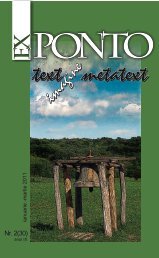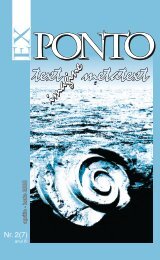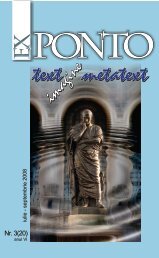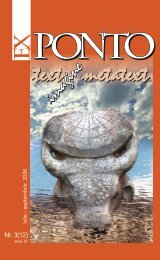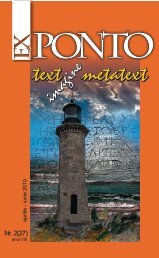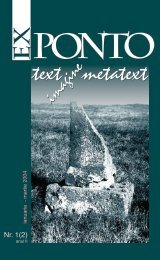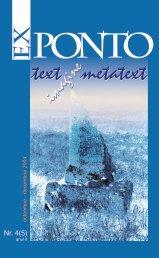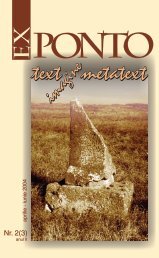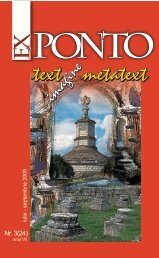Nr. 3 (32) anul IX / iulie-septembrie 2011 - ROMDIDAC
Nr. 3 (32) anul IX / iulie-septembrie 2011 - ROMDIDAC
Nr. 3 (32) anul IX / iulie-septembrie 2011 - ROMDIDAC
You also want an ePaper? Increase the reach of your titles
YUMPU automatically turns print PDFs into web optimized ePapers that Google loves.
Another issue is that of the strictness of Catholicism. We infer from Kate’s<br />
being dismissed that the priest in Ballybeg is authoritarian and cruel. The<br />
positive religious aspect consists in Father Jack’s heroism as a result of his<br />
missionary work in Uganda. The priests’ harshness actually decreased the<br />
authority of the Church. Thus, economic, religious and social reasons may<br />
account for the pattern of Irish emigration and the plight of London’s homeless<br />
Irish, such as Agnes and Rose.<br />
Friel has repeatedly claimed that his plays are addressed to an Irish<br />
audience and that in Dancing at Lughnasa he wrote about his Glenties aunts<br />
not for export but for his fellow countrymen, with a focus on the connection<br />
between the past and the present and on “Irish issues”. That fact that the plays<br />
speaks to the world means that Ireland and the world fundamentally share<br />
some values and concerns.<br />
Since 1999 it [Dancing at Lughnasa] has been produced around the<br />
world, on national, regional, university and amateur stages. In 1998 a<br />
film version appeared, scripted by Friel’s fellow Donegal playwright Frank<br />
McGuiness and starring Meryl Streep. The Abbey mounted a second<br />
production in 1999, as part of the Friel Festival celebrating the playwright’s<br />
seventieth birthday. (Lojek 88)<br />
In conclusion, the Mundy sisters’ story may not have caused a revolution,<br />
in the sense that, in the end they had to comply with the system or they were<br />
defeated by it, but their contribution may make a difference. They lead their<br />
lives in poverty and meager circumstances, yet, their humour, support of each<br />
other and refusal to break allows them to provide a coherent pattern, like in<br />
the illuminating moment of their dance. Their lesson resembles, according<br />
to Friel, the task of the artist: to make us “recognize that even in confusion<br />
and disillusion, strength and courage can exist, and that out of them can<br />
come redemption of the human spirit” (qtd. in Roche 88). The Mundy sisters’<br />
revolution may not be a political one but it certainly is a spiritual challenge.<br />
Women may challenge authority, in Friel’s plays, through linguistic means, such<br />
as in witty Maggie’s case, but what is more characteristic of their moment of<br />
rebellion is performance providing liberation from confining gender role:<br />
It [the sisters’ dance] performs a moment of interconnection not only<br />
between the sisters (though the eldest, Kate, keeps to her own space),<br />
but also with an earlier time in Irish pagan history when the festival of<br />
Lughnasa was an active community ritual, and with other cultures, such<br />
as the leper colony of Ryanga, whose public rituals Father Jack praises.<br />
(McMullan 145)<br />
Ex Ponto nr. 3, <strong>2011</strong><br />
Ironically, such an instance tends to construct female identity in terms of<br />
the corporeal “other” to resist social and male authority, of which the audience<br />
is to become aware through the narrator’s voice, especially that there is some<br />
distance between the audience and the dance cause by the fact that it is the<br />
man’s memory that creates this vision. Michael, the adult, relies on childhood<br />
memories and gilds everything in a golden “mist”, ignorant of poverty, exile<br />
and death, trustful, yet aware of the subversive nature of the play of his<br />
memory.<br />
180




